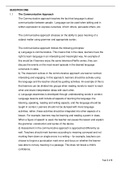QUESTION ONE
1.1 The Communicative Approach
The Communicative approach teaches the fact that language is about
communication between people. Language can be used when talking and in
written expression to express ourselves, inform others, persuade others, etc.
The communicative approach stresses on the ability to pass meaning of a
subject matter using grammar and appropriate syntax.
The communicative approach follows the following principles:
a) Language is communicative. This means that in the class, learners have the
right to learn language in an interesting and meaningful way. An example of
this would be if learners enjoy the same television/Netflix series, they can
discuss the events on the most recent episode in the desired language
constructs in class.
b) The classroom actives in the communicative approach are learner centred,
interesting and engaging. In this approach, learners should be actively using
the language and the teacher should be guiding activities. An example of this is
that learners can be divided into groups when reading novels to read it to each
other and share interpretation ideas with each other.
c) Language awareness is developed through understanding words in context.
Language lessons sold include all aspects of learning the language: the
listening, speaking, reading and writing aspects, and the language should be
taught in context. Learners should not be dumped with mere language
activities, rather, these activities should be integrated into other aspects of a
lesson. For example, learners may be learning and reading a poem in class.
When a figure of speech is used, the teacher can pause the lesson and explain
the grammar, construction and syntax of the device.
d) Assessment in the communicative approach is approached differently as
well. Teachers should mark learners according to meaning conveyed and not
marking them down on single errors in a writing – for example, teachers can
choose to forgive a punctuation mark error and focus on whether the learner
was able to convey meaning in a passage. This does not break a child’s
confidence.
Page 2 of 8
, e) The communicative approach does not state or dictate any particular
method to
teaching. Teachers should teach a language on a level that is appropriate for a
learner’s developmental level, needs, barriers and interests. For example, if the
class is interested in a particular subject matter, teachers can base their lesson
plans around that.
f) The target language should be taught in a way that is free from discrimination
and embarrassment. It must be a safe space for learners to express
themselves. As a teacher, one should be a role model and not laugh at or
mock at learners for making mistakes. For example, if a learner makes a
spelling mistake but has conveyed
the desired meaning, the teacher must react respectfully in a way that corrects
the mistake but recognises that the message was conveyed.
g) The teacher is meant to be a facilitator in the process of learning. The
teacher is not meant to talk the entirety of a lesson. Teachers must guide the
learning process but allow learners to practice and learn independently as well.
An example is that learners work together on their dialogues, sharing ideas and
plans, whilst the teacher has given a basic guide and topic. Learners can then
also assess one another, with a rubric from the teacher. The teacher gives
suggestions of improvement.
h) Lastly, experimentation must be encouraged. Teachers need to provide
opportunities where learners are able to experiment with the language in a safe
and calm environment. Perhaps inculcate opportunities for speaking that is
more unprepared, or writing that is freehand, like diary entries.
1.2 A Learner-centred Approach
A learner-centred approach stresses that the teacher is as a facilitator of
learning
rather than a “lecturer” who does all the talking and is recited back to. Learners
have
opportunities to actively engage with a language to empower them and they
must do
more of the speaking in the classroom than the teacher – this follows the 20/80
rule where the learners speak 80% of the lesson.
Learner-centred classrooms will have the following features:
Page 3 of 8




